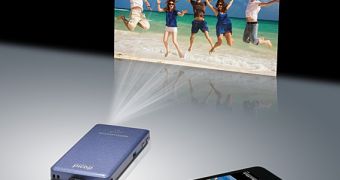Microvision, a leader in the innovation of a new generation of display and imaging products for mobile applications, has introduced its new SHOWWX, the world’s first laser pico projector. Complying with "made for iPod" standards, the device connects to TV/Video-Out-capable devices, including the iPod nano, iPod classic, and iPod touch. No mentioning of iPhone compatibility is made on the company’s website.
TV/Video-Out is a capability that allows devices like Apple’s iPod touch to send a video signal to another device, in this case the SHOWWX. iPods provide a TV/Video-out signal for picture slideshows and video content (music videos, full-length movies, video Podcasts, etc.) making the acquisition of SHOWWX a smart move for those who always have something to show off. According to Microvision makers, the key features of the SHOWWX include: - Always in focus: you never, ever have to adjust focus; - Sharp and clear images on any surface from 6 inches or less to 200 inches or more; - Rich and vivid laser colors amplify your photos, videos and presentations; - Wide projection angle delivers a big image (1:1 throw ratio); - High resolution (WVGA 848x480) brings out every detail; - Widescreen (16:9) aspect ratio enables you to experience content the way it was meant to be; - Sleek contours feel great in your hand; slim enough to put in your pocket; - Plug-n-play compatibility enables quick and easy operation with your device; - Movie-capable battery that lasts 90-120 minutes on a single charge.
A little bigger than an iPod touch, the SHOWWX projects at WVGA resolution (848 x 480), boasts a 10 lumen brightness and a 60 Hz (nominal) refresh rate. The Color Gamut is bigger than 200% NTSC. Aiming to bring the SHOWWX to the U.S. in March 2010, Microvision still hasn’t set the price point on this product. Upon shipping, the SHOWWX will come with a rechargeable battery, a wall charger, a cable for iPod, a composite adapter, a storage pouch, a micro-USB cable, a wrist strap, and a user guide.
Update: this article has been slightly modified to correct the company name "Macrovision" to "Microvision", as reader Nullibiquitous points out in the comments.

 14 DAY TRIAL //
14 DAY TRIAL //